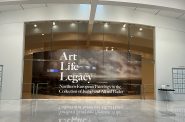Tableclothes, Tea and Take-out at Dean Jensen and WPCA
My desk chair creaks as I lean back. It’s a good creak, as it should be, since the chair is about 95 years old. The dark polished seat and slated back are subtly contoured, made of walnut, an armless stenographer’s chair from the World War I era. You see this sort of chair in old movies. It’s a design that stuck around into the ‘40s; it shows up in old black-and-white movies, underneath secretaries working for hard-boiled private eyes and cub journalists in chaotic, intense newsrooms.
Decorative Directive at Walker’s Point Center for the Arts
Decorative Directive, closing this weekend at Walker’s Point Center for the Arts, threads together ideas on etiquette, heirlooms and the niceties of the past. Featuring works by Regan Golden, who is trained in drawing and painting, and Jennifer Harris, whose background is in metalsmithing and industrial design, fills two galleries with large- scale installations and small-scale works on paper. Prints and drawings fall into the traditional media category, but much of the rest does not; big thick sheets of pierced and torn paper are treated like sculpture, and electrical cords make delicate patterns reminiscent of brocade.
The centerpiece of the show, physically and aesthetically, is Harris’ Etiquette Tablecloth (2005), neatly spread over a long table with white chairs. At first glance, one wonders if it’s been left over from a party, empty but ready for entertaining. The cloth is embroidered, white on white, with instructive details on the art of dining. Circles mark the position of plates; four smaller circles at each place setting are labeled for glasses: water, sherry, wine, and dessert. An array of forks, knives, and spoons surround each place, but don’t let your heart start palpitating in fear of spearing your fish with the dessert fork; the order in which the utensils are used is numbered. Seating places are labeled; the host sits here, the hostess here, the lady of honor there, and so on down a hierarchy of assorted guests. The table traffic pattern is regulated by directional arrows pointing out the flow of dishes, which way things are passed, where things are served from. I admit to studying closely and picking up some pointers.
Etiquette Tablecloth is a lovely thing to look at, in the elegant crispness of the cloth and authoritative stitching. It suggests the invisible dance of dinner unfolding. Really, if you are going to use this quantity of silverware and glasses, you know you’ll be seated for a while. And this is where the imagination can take hold: the conversations, the topics of interest and intrigue, dialogue played out over the ritual of a shared meal and the social graces surrounding it. Here on this cloth, the possibilities of an evening are suggested, like the anticipation of a well-laid table with silver and china gleaming under candlelight.
Elsewhere in the exhibition, Harris juxtaposes these ideas with sketches, as well as a cafeteria tray exploring the “etiquette” of fast food, and of frozen food. There’s not much to explore in the way of formality, but the artist’s attempts to nail down the codification of proper placement for paper wrapper, plastic utensil, and disposable soda cup are rather funny. Sad, but funny. Harris also references the social rigors of consumption in other ways, including the social and physical accoutrements of taking tea.
Works by Regan Golden explore formal properties insinuated by a pearl necklace, with notions of heirlooms and jewelry that belong to an older generation, unavoidably imbued with a sense of memory and identity. Though many of her pieces operate on a large scale, they are impermanent and insubstantial; it feels as though all of these things could literally be packed away into a steamer trunk, though it’s unlikely the paper and plastic survive. Her works suggest disintegration and temporality; they’re not made of material or craftsmanship to last.
Many pieces in this exhibition share this trait of transience. While physical artifacts and social habits of the cultural past are pointed to, the overwhelming sense is that these are lost hopes, lost arts. This is underscored in the level of craft throughout: a weightiness of physical importance is missing. Things are not meant to be around, and their materials and fragility reflect as much. Permanence and gravitas are not expectations.
Susana Raab: Rank Strangers at Dean Jensen Gallery
Susana Raab, The Unfortunate Result of the Demise of the Public Phone Booth, Metropolis, Illinois. Chromogenic Print.
Culture, impermanence and identity feature significantly in photographer Susana Raab’s exhibition Rank Strangers at Dean Jensen Gallery. Her large-scale prints are fascinating, funny and often poignant scenes of Americana, populated by sleepy, pint-sized Elvises, unauthorized Ronald McDonalds, Colonel Sanders impersonators, and other flotsam of fast food culture. A number of these pieces are taken from Raab’s series Consumption, which examines this subject, but those are augmented by images that take a similar approach to other subjects of American life.
Raab, whose work as a photojournalist has twice been shortlisted for a Pulitzer Prize, reveals a gift for narrative, timing, humor and composition. She is ready, camera in hand, to catch Superman exiting the Port-o-Let, broad chest out, cape billowing, his unitard vibrant against the green plastic. The title, The Unfortunate Result of the Demise of the Public Phone Booth, is so apt.
Raab finds a most romantic moment in Chicken in Love, Athens, Ohio. Star-crossed lovers, a teenage girl and a chicken (or at least someone outfitted in full-body, feathery regalia) hold hands and play footsy underneath the table in some fast food eatery, while blurry passersby are just visible at the edges of the scene. They add to the ordinariness of the situation; this is just everyday in America. It’s a funny picture, but sweet, as it apparently proves that love is indeed blind. If your beloved can dress up like giant poultry but you can still see right through the feathers, holding hands and gazing with oblivious devotion, there must be something there. Heartwarming, in a heat-lamp-over-the-burgers sort of way.
The fun and color of Raab’s work is engaging, fun, but provocative as well. She reveals an odd side of contemporary culture that revels in a lack of inhibitions: irreverent, identity-changing costumes; the carnivalesque atmosphere of consumption and disposability that permeate our landscape. This is the antithesis to the formalities implied by Jennifer Harris’s Etiquette Tablecloth. Two ends of the spectrum seeming to distinguish past and present, permanence and tradition versus transient entertainments. Neither of these exhibitions are firmly cautionary or critical on these matters, simply suggestive of perspectives.
I lean back in my creaky chair and contemplate a dinner party, tablecloth and all.
Decorative Directive
Closes Saturday, August 22
Walker’s Point Center for the Arts
911 W. National Avenue
414-672-2787
Tuesday – Saturday, Noon – 5pm
Susana Raab: Rank Strangers
Closes August 29
Dean Jensen Gallery
759 N. Water Street, 414-278-7100
Tuesday – Friday, 10 am – 6 pm
Saturday, 10 am – 4 pm
Art
-
Exhibit Tells Story of Vietnam War Resistors in the Military
 Mar 29th, 2024 by Bill Christofferson
Mar 29th, 2024 by Bill Christofferson
-
See Art Museum’s New Exhibit, ‘Portrait of the Collector’
 Sep 28th, 2023 by Sophie Bolich
Sep 28th, 2023 by Sophie Bolich
-
100 Years Of Memorable Photography
 Sep 18th, 2023 by Rose Balistreri
Sep 18th, 2023 by Rose Balistreri

















